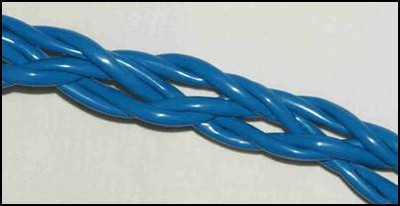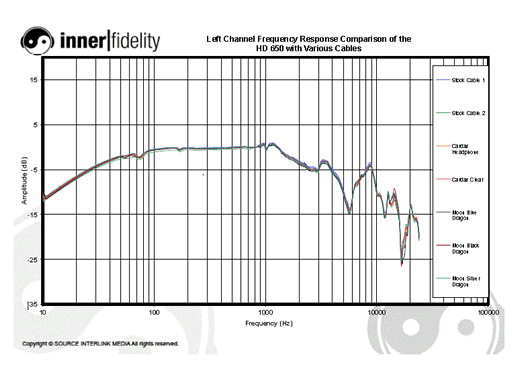- AccurateRip
- Acoustid
- AES/EBU
- AirPlay
- Amplifier
- aptX
- Audio file formats
- ASRC
- AVB
- Bit perfect jitter
- Bits: 16 or 24
- Bit perfect playback
- Bitrate
- Bluetooth
- Burn-in
- BWF
- Cables
- CDtext
- Chromecast
- Clipping
- Clock
- Codec
- Compression
- CRC
- Crossover
- Cue sheet
- DAC
- Damping
- DASH
- Digital
- Digital Room Correction
- Dither
- DLNA
- Drivers
- DoP
- DSP
- EBU R128 (loudness)
- FFT
- FireWire
- Freedb
- Gapless playback
- Generation loss
- HDMI
- Headphone listening
- Hearing
- Hires recording
- Homeplug
- I2S
- ID3
- Inter sample peak
- LDAC
- Linearity (DAC)
- Memory playback
- Music Server
- OCF
- OFC
- PCM
- Perception
- RAID
- ReplayGain
- Ripping
- RFI
- RIAA
- Router
- Sampling, up and over
- Sample Rate Conversion
- Speakers
- S/PDIF
- Storage
- Sync
- Tagging
- Toslink
- Transcoding
- UAA
- Units
- UPnP
- USB
- VST
- WiFi
- WiSA
Speaker cables
Jim Lesurf measures the resistance of a couple of speaker cables against the frequency.
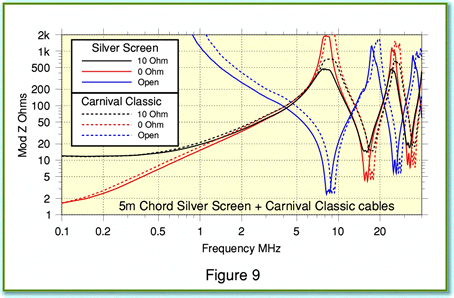
Looks impressive, wild variations in resistance over the frequency range.
Sure these passive components behave like wild.
Now 1 MHz = 10E6 = 1.000.000 Hz
The upper limit of our audible range is 20.000 Hz= 0.02 MHz.
So what do these measurements learn us?
Roger Russell discusses all kind aspects like resistance, materials , lifters etc.
John Siau of Benchmark Media tested frequency response of various cables.
As an objective audiophile, I have occasionally been surprised by the unexpected:
I decided to test speaker cables to show that the differences are insignificant. I expected to demonstrate that 18-GA zip cord was indistinguishable from high-quality audiophile speaker cable or even the heavy-gauge cables used by the sound reinforcement industry. I was shocked to discover that there were differences, and more shocked to discover that the zip cord performed better than most of the other cables!
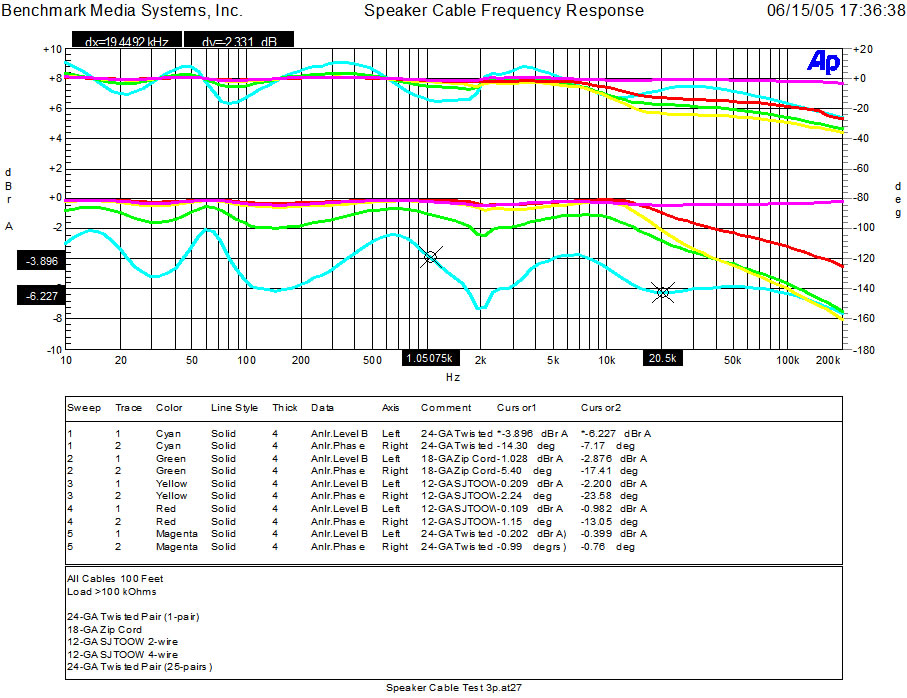
This test uses 100 ft cable with a 8-ohm JBL 4410 3-way studio monitor as load.
The DC resistance of the cables and impedance variations in the speakers cause the dips in the frequency response..
The inductance of the cable causes the high-frequency roll-off.
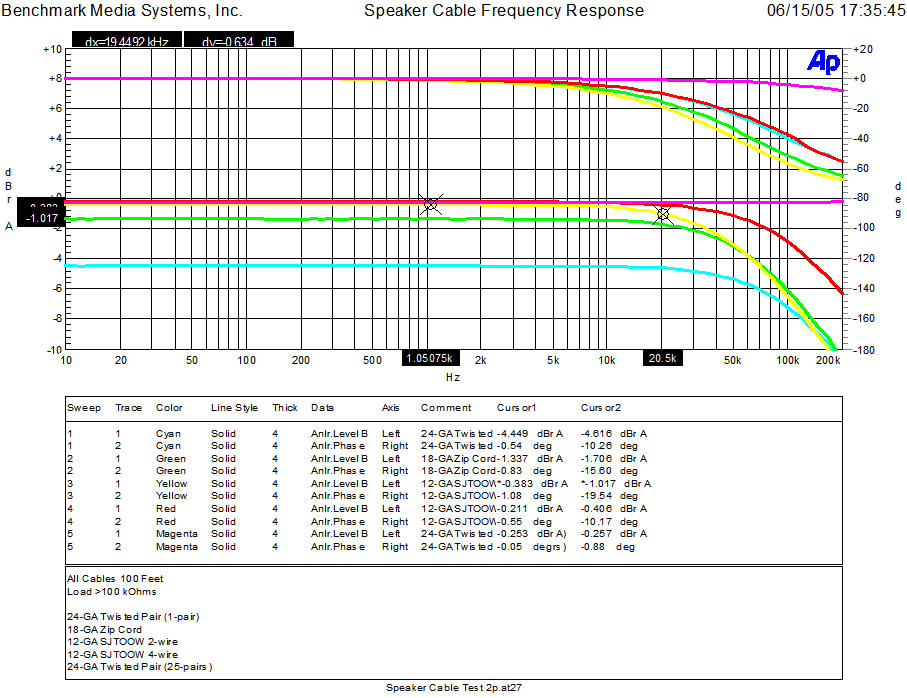
The same test with a 8-ohm resistive load,( also showing phase response) is less dramatic now that the impedance variations by the speakers are eliminated.
However both phase and frequency response are affected inside the audible range.
Yes speaker cable do matters but you have literally gone at great length (100 ft) to show the impact.
With short runs as common in the home (<12 ft) you won’t have this problem.
The best performer is the magenta one, 24 strands of 24-GA twisted pair cable.
Sound familiar as indeed most CAT5 cable is made of 24-GA twisted pair!
In other words:
- crab a bunch of CAT5 cable,
- connect them parallel between amp and speaker
- you can bridge even 100 ft without a problem
- at marginal cost
When Peter Walker first revealed his Quad ESLs to the audio press he forgot to bring along cables. While his assistants were setting up he dashed out to a local hardware store and grabbed some appropriate cords. He snipped the ends off of, stripped them and connected them. After the presentation many of the reviewers were as curious about the cables as they were about the speakers, thinking that these orange cables they'd never seen before must have had something to do with the marvelous result. And so Walker was queried as to the brand, to which he truthfully replied: "Black and Decker!"
Headphone cables
Innerfidelity’s Tyll Hertsens measured the frequency and impulse response of a Sennheiser HD 650 using various headphone cables.
Conclusions?
The most important conclusion I came to doing this test was that my measurement gear is surprisingly repeatable. I'm very happy with that.
Do I see anything that might be characterized as an audible feature due to the different cables in the measurement? Nope. Nada. Zilch. Like I said earlier in this article, this gear is simply not the right kind of tool for the job of characterizing cables. On the other hand, this measurement system is designed to quantify the audibility of certain sound characteristics, and these measurements would tend to indicate the audibility of cable changes is very low. I have to again state my experience is that the changes in the sound I hear with cable swaps is subtle.
Headphone Cable Measurements - Tyll Hertsens
oxygen-free copper
I have absolutely nothing against oxygen-free copper because nobody has been
able to prove to me that it sounds in any way inferior to normal copper.
Low oxygen copper was created for the windings of large electrical generators (like the utility companies use). It was found that an amount of oxygen (from the air) bonds into the copper during the smelting process. This oxygen causes the copper to become brittle, over time, at points where it is heated (usually from high current flow. Thus the low oxygen has NOTHING to do with sound quality and everything to do with mechanical wear and tear (which is important to the lifecycle times of large, expensive, utility power generators). Further, pretty much ALL copper made now-a-days is low oxygen.
Todd Gearheart
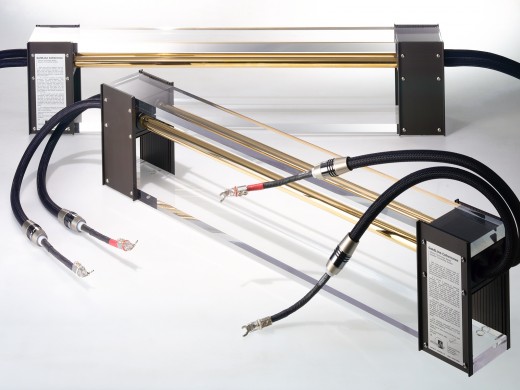
fadel Art GoldLine Coherence € 12.800
- Taking the lead - Jim Lesurf
- RF Speaker Cables - DonH50
- Speaker Cable Faceoff 3 - The DIY Shootout - Thomas Goldsworthy
- Headphone Cable Measurements - Tyll Hertsens
- Speaker Cable Guide - Tonestack.net (2019)
- Speaker Wire A History - Roger Russell
- Speaker cable guide - tonestack.net


